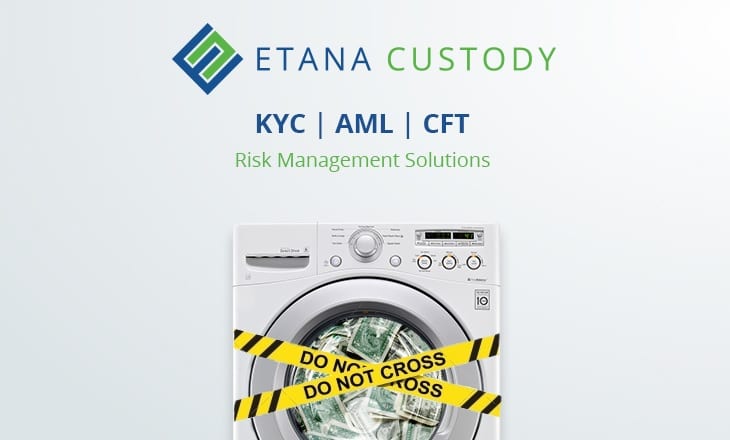The following article was written by Brandon Russell, CEO of Etana Custody.

Brandon Russell, CEO of Etana Custody
In the modern globalized world money launderers and other criminal elements have come up with plenty of resourceful ways to cover their tracks. It is a common practice among such groups to use the everyday activities of legitimate entities such as banks, credit unions and other financial service providers in order to have their ill-gotten earnings ”clean”. On the other hand, in order to counter such activities, financial institutions rely mostly on a system of rules and procedures aimed at acquiring knowledge of their customers, also known as KYC.
One of the major issues, often pointed out by experts in the field, however, is that legitimate entities used for money laundering may turn out to be not compliant with Anti-Money Laundering (AML) regulations, because the latter tend to be way too diverse. What is more, due to the probability that ”laundered” funds could be used for financing drug-related, terrorist and other criminal activities, the topic of AML compliance has already been included in the national security policy agenda.
Let us also not forget that banks and other financial institutions, which have facilitated money laundering one way or another, even unintentionally, will usually suffer enormous penalties.
Therefore, it is of utmost importance for financial institutions to establish a reliable system of controls, allowing them to identify unusual money flows and transactions even when criminal elements are using the best of their ability to circumvent rules. In order to assist banks and other non-bank financial institutions, regulatory authorities worldwide have provided guidelines for risk-based compliance models. By using the latter, financial institutions are enabled to review and evaluate their regular markets, transactions and processes, and thus, determine the level of money laundering risk.
As criminal elements have become quite adept at using banks as well as other financial service providers for their purposes, regulatory authorities worldwide have put a serious emphasis on the Know Your Customer framework.
The Customer Identification Program is usually the initial step in any KYC procedure. At this stage, financial institutions are required to collect and document the name, address, date of birth and identification of every customer.
The Customer Due Diligence represents the second phase in the procedure, where further information is gathered for the purpose of customer identity verification and risk assessment. In order to do so, banks and other financial institutions collect data in regard to:
- the nature of their clients’ business,
- the purpose of their account,
- the origination and destination of their funds,
- expected account activity, or volume and nature of their transactions,
- nominal and beneficial owners of the account,
- their clients’ customer base,
- business documentation,
- reputation and references,
- location of business operations in relation to the bank/financial institution and etc.
In case the standard Customer Due Diligence concludes that a particular customer has a high-risk profile, the financial institution is obligated to conduct an Enhanced Due Diligence. Used particularly in Private Banking and Off-Shore Banking, it is a more thorough and more accurate procedure, which needs to be documented so that regulatory authorities are able to inspect it. Such a procedure needs to meet the so called ”SMART” requirement, or it must be specific, measurable, achievable, relevant and timebound. It also needs to be scalable, commensurate to resources and risk, and to be based on relevant adverse information (information gathered from any source, which directly or indirectly suggests involvement in terrorist funding, money laundering or predicate offenses).
At the next stage, banks and other financial institutions utilize the collected data in order to establish a customer profile model against which his/her account activity is monitored. This way, doubtful transactions can be identified with the use of AML software models. Data is usually compared to lists of individuals suspected of involvement in particular criminal activities, corruption, as well as lists containing PEPs (politically exposed persons).
It is an undeniable fact, however, that many financial institutions are still using AML systems, based on obsolete rules and scenarios, which generate millions of ”false positives” (or notifications related to transactions that appear to be completely in order) per year. Such a huge amount of signals, in turn, requires quite an expanded compliance department to investigate.
A recent research by AML technology firm Fortytwo Data revealed that banks were spending £2.7 billion per year investigating false positives due to outdated AML systems. At the same time, spending by financial institutions and firms operating in other AML compliance-regulated industries is projected to increase to £6.4 billion in 2017 on a global scale and reach its peak at around 2020, as they all seek to upgrade their AML systems due to tremendous regulatory obligations. Meanwhile, companies adopting modern machine learning technologies are expected to reduce the capacity of their compliance departments by at least 75% by the year 2025.
Machine learning technologies are capable of assessing money laundering risk without the need for human interaction. Such platforms are able to quickly make the distinction between high-risk transactions and false positives, as they model human behavior and analyze the correlation between data sets.
Endeavors such as these reveal an evident global tendency aimed at reforming compliance environment.
In an attempt to keep up with relentless dynamics within the field of financial technology and, at the same time, meet a complex set of compliance regulations worldwide, Etana Custody took a step further by partnering with a global leader in risk management solutions. In so doing, Etana is able to offer our clients not just a solution, but an opportunity to build and maintain a culture of compliance and to ensure their operations perform at maximum capacity.
By using our solution, brokerage companies are able to overcome unique language and jurisdictional challenges when it comes to compliance procedures such as Know-Your-Customer and Anti-Money Laundering, recognizing and spotting Politically exposed Personas (PEPs).
With Etana’s risk management solution our clients are enabled to screen and verify their suppliers, partners and other contracting parties against a strictly monitored, top-quality risk database. But what is more, by employing the cutting-edge innovation in technology, provided by our compliance partner, brokerage companies can comfortably manage enterprise risk, regulatory compliance risk as well as customer and third party risk.
Due to the global nature of our clients’ business operations as well as because of the specifics of regional regulatory and risk management standards, the need for flexibility is paramount. By partnering with Etana Custody, brokerages are granted the opportunity to customize and streamline the data flow in accordance with their business needs and risk appetite through a set of valuable features.
Last but not least, by utilizing the comprehensive and trusted intelligence, brokers are able to take advantage of additional benefits such as lower operation costs and heightened credibility.
